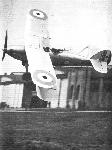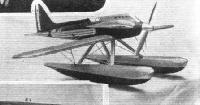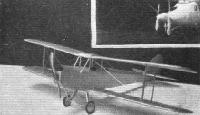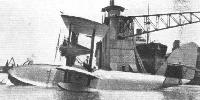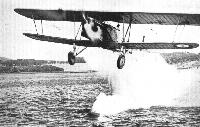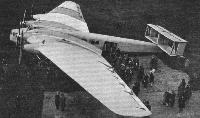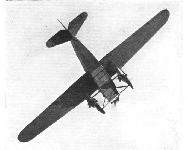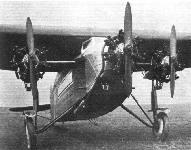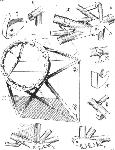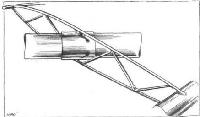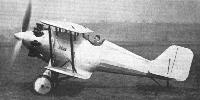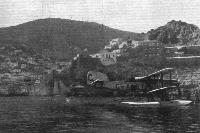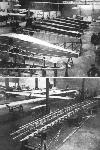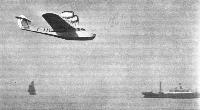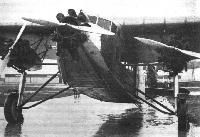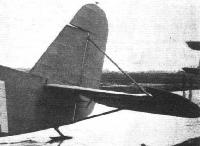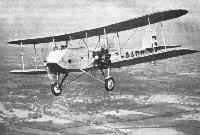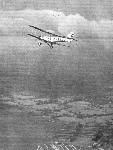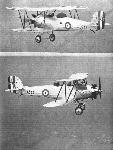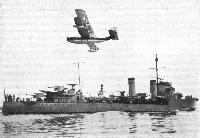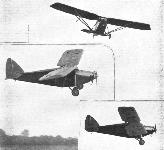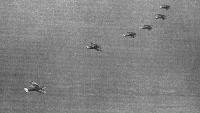Фотографии
-
THE FIRST CANADIAN AIR PAGEANT AT MONTREAL: The U.S. Army Curtis PI's are formating on the left. On the left is a Ford Tri-motor, while next to it are two Lockheeds, with N.A.C.A. cowling and speeds of about 190 m.p.h. The one with the dark fuselage is Capt. Hawks' transcontinental record machine.
Самолёты на фотографии: Curtiss F6C / P-1 / Hawk / Model 34 - США - 1925Ford Tri-Motor / 4-AT / 5-AT - США - 1926Lockheed Air Express 3 - США - 1928
-
Регистрационный номер: J9052 A RECONNAISSANCE FLEET FIGHTER: Extremely clean lines characterise the Hawker "Hart." Note the careful cowling of the Rolls-Royce "F" type engine and the sheltered position of the rear gunner.
Самолёты на фотографии: Hawker Hart - Великобритания - 1928
-
Регистрационный номер: G-AAGU Major M. S. Marsden with his pilot, Major J. N. C. Clarke, and ground engineer, Mr. F. G. Amer, of the Air Express Co., Croydon. They are running Junkers F.13's for what might be called "The Daimler Hire Service of the Air."
Самолёты на фотографии: Junkers F 13 - Германия - 1919
-
Регистрационный номер: G-EBIX NEW WINE IN OLD BOTTLES: A Handley Page biplane which has been fitted with Rolls-Royce "F" engines.
Самолёты на фотографии: Handley Page H.P.18 (W.8) / H.P.30 (W.10) - Великобритания - 1919
-
Регистрационный номер: N220 Scale model of the Supermarine "S.5"
Самолёты на фотографии: Supermarine S.5 / S.6 - Великобритания - 1927
-
A LINK WITH THE PAST. When I was turning out some drawers the other day the enclosed photo came to light. Perhaps it may be of interest to you.
One fine July morning in 1911, and about 7 a.m., some of us, students, who were on the top floor of the Agricultural College at Uckfield, Sussex, were surprised to hear, what was then, the unaccustomed noise of two rotary motors. Looking out of a window we saw two biplanes, one of which is the subject of the photograph. This one promptly did a forced landing in a field nearby. Its pilot and passengers sitting "pick-a-back" were Messrs. Pizey and Fleming. The accompanying machine, a Bristol of the same type, and piloted solo by Mr. Gordon England, whose flying kit consisted of a cap reversed and an ordinary lounge suit with layers of newspaper under the waistcoat (!) did a perfect landing on Uckfield recreation ground at rear of college. Our principal invited the airmen to have breakfast at the college, which they did, and later in the day we had the pleasure of repairing parts of the damaged left wing in the carpenter's shop. This repair was apparently sufficiently airworthy to allow of the machine being flown away the next morning.
A. BERTOLACCI, Worthing. late R.A.F. November 18, 1929.Самолёты на фотографии: Bristol Boxkite - Великобритания - 1910
-
A Caterpillar Tractor is a useful airport "accessory," which can be employed for hauling the aircraft from the aerodrome to the hangar, and vice versa, as shown here.
Самолёты на фотографии: Armstrong Whitworth Argosy - Великобритания - 1926
-
Scale model of the D.H. "Moth"
Самолёты на фотографии: De Havilland Moth / D.H.60 - Великобритания - 1925
-
Регистрационный номер: G-EBRL A "Widgeon" in its native element!
Самолёты на фотографии: Westland Widgeon - Великобритания - 1924
-
WESTLAND "HERMES-WIDGEON"
Самолёты на фотографии: Westland Widgeon - Великобритания - 1924
-
Самолёты на фотографии: Westland Widgeon - Великобритания - 1924
-
Самолёты на фотографии: Canadian Vickers Vancouver - Канада - 1929
-
Самолёты на фотографии: Canadian Vickers Vancouver - Канада - 1929
-
DROPPING A "MOULDIE": A Hawker "Horsley" of No. 36 Squadron discharging its torpedo over the Firth of Forth. It will be recollected that the long-distance "Horsley," generally similar to the Service type, carried more than its own weight in fuel, crew, etc.
Самолёты на фотографии: Hawker Horsley / Dantorp - Великобритания - 1925
-
Регистрационный номер: D-2000 [4], D-AZUR [4] THE AGE OF THE LARGE AIRCRAFT: The Junkers G.38 has now been completed and has made its first test flights. The machine is a step towards Dr. Junkers' ideal of the "flying wing." The machine is fitted with 4 Junkers I.55 engines, partly housed in the wing, and has a span of 147-5 ft.
Самолёты на фотографии: Junkers G 38 - Германия - 1929
-
Регистрационный номер: D-2000 [4], D-AZUR [4] Самолёты на фотографии: Junkers G 38 - Германия - 1929
-
Регистрационный номер: D-2000 [4], D-AZUR [4] Самолёты на фотографии: Junkers G 38 - Германия - 1929
-
Регистрационный номер: D-2000 [4], D-AZUR [4] Самолёты на фотографии: Junkers G 38 - Германия - 1929
-
THE BLACKBURN "IRIS III": The latest model of this type, built to order of the Air Ministry by the Blackburn Aeroplane and Motor Co., Ltd., was successfully launched at Brough on November 21. The new "Iris," which is of all-metal construction, has three 700 h.p. Rolls-Royce "Condor" engines, and weighs a matter of some 13 tons. An unusual feature of this machine is the provision of a gunner's cockpit at the extreme rear of the hull, immediately behind the tail 'planes. Sqdn.-Ldr. Rea, accompanied by Mr. W. D. Marriott, Mr. McCallum (representing the Air Ministry) and Maj. J. T. Rennie, of Blackburn's, carried out the launching flights last week, after which the flying-boat proceeded to Felixstowe to undergo service trials.
Самолёты на фотографии: Blackburn Iris / R.B.1 - Великобритания - 1926
-
Самолёты на фотографии: Arado L.II - Германия - 1929
-
The inverted "Argus" As8 engine is here shown exposed and, on the right, as mounted and cowled-in on the Arado "Treff As."
Самолёты на фотографии: Arado L.II - Германия - 1929
-
Arado Type L.II 80 hp Argus As 8 Engine
Самолёты на фотографии: Arado L.II - Германия - 1929
-
AT THE KAI TAX AERODROME, HONG KONG: The "Avian-Hermes" of the Far-East Aviation Co. Mr. Smith (in white trousers) is a director, and Mr. Vaughan Fowler is manager and pilot.
Самолёты на фотографии: Avro Avian / Type 594/616 - Великобритания - 1926
-
P. T. Eckersley, Captain of the Lancashire County Cricket Team and a keen pilot of a Hermes-Avian.
Самолёты на фотографии: Avro Avian / Type 594/616 - Великобритания - 1926
-
OFF: The Avro Ten taking off on a test flight at Woodford Aerodrome, piloted by Flight-Lieut. John Oliver, A.F.C.
Самолёты на фотографии: Avro Ten / Type 618 - Великобритания - 1928
-
THE AVRO 10: Another type of three-engined monoplane, added to the fleet in 1931.
Самолёты на фотографии: Avro Ten / Type 618 - Великобритания - 1928
-
Самолёты на фотографии: Avro Ten / Type 618 - Великобритания - 1928
-
FRONT VIEW OF THE AVRO TEN: Three Armstrong Siddeley "Lynx" Engines.
Самолёты на фотографии: Avro Ten / Type 618 - Великобритания - 1928
-
The Avro Ten: A close-up of the nose showing the three "Lynx" engines. Wheel brakes are fitted to the landing wheels.
Самолёты на фотографии: Avro Ten / Type 618 - Великобритания - 1928
-
The Avro Ten: In the three-quarter front view the man standing in front gives "scale" to the picture.
Самолёты на фотографии: Avro Ten / Type 618 - Великобритания - 1928
-
AVRO WELDED STEEL TUBE CONSTRUCTION: Circular engine mountings of the type shown in 1 are used both for fuselage and wing engines, but the actual supports of the rings differ slightly. The joint to the top longeron is shown in 2, with end fitting before welding shown at A and B. The fitting at the lower longerons is illustrated in 3, with details in 3C. The type of cowling support and attachment is shown in 4. In 5 is shown engine bracket before it is welded on to the engine ring, and 6 shows a bracket, a portion of the ring, and the attachment of a cowling tube.
Самолёты на фотографии: Avro Ten / Type 618 - Великобритания - 1928
-
AVRO WELDED CONSTRUCTION: A typical fuselage joint.
Самолёты на фотографии: Avro Ten / Type 618 - Великобритания - 1928
-
AVRO WELDED CONSTRUCTION: In the tail plane use is made of internal diagonal tubular struts of high-tensile steel. To avoid welding direct to this, mild-steel sleeves are used, as shown. The sketch also illustrates the welded tube tailplane ribs, the web being formed of continuous tubes welded to the flange booms.
Самолёты на фотографии: Avro Ten / Type 618 - Великобритания - 1928
-
Регистрационный номер: N236 Scale model of the Blackburn "Beagle-Jupiter"
Самолёты на фотографии: Blackburn Beagle / BT.1 - Великобритания - 1928
-
Самолёты на фотографии: Blackburn Lincock / F.2 - Великобритания - 1928
-
Самолёты на фотографии: Blackburn Lincock / F.2 - Великобритания - 1928
-
CONSOLIDATED: The Type PY-1 "Admiral" monoplane flying-boat, fitted with two 450-h.p. Pratt and Whitney "Wasp" engines, constructed by the Consolidated Aircraft Corporation of Buffalo, N.Y. A similar machine, a 22-seater commercial model (type "Commodore"), was recently delivered to the New York and Rio and Buenos Aires Line, Inc., for operation on the air service between New York and Buenos Aires. lt formed the first of a batch of 12 ordered, and was named "Buenos Aires," by Mrs. H. Hoover. The commercial models are equipped with 500-h.p. Pratt and Whitney "Hornet" engines.
Самолёты на фотографии: Consolidated Commodore / PY Admiral - США - 1929
-
Регистрационный номер: G-AABY British Enterprise Abroad: This Fairey IIIF (type F.A.A.) was recently flown (as a land machine) to Greece by C. R. Mc Mullin, and was then converted into a seaplane. In both forms it favourably impressed the Greek authorities who made a thorough inspection of the machine. It is seen just outside the island of Hydra, with the summer Palace of the Greek President in the background.
Самолёты на фотографии: Fairey Fairey IIIF - Великобритания - 1926
-
Регистрационный номер: G-AAPK Above are the new workshops which will cater for the needs of the whole of the N.F.S. organisation. Below, two passengers about to "enplane" in one of the new Desoutter cabin machines (with Cirrus "Hermes" engines), which N.F.S. have standardised on their taxi-service.
Самолёты на фотографии: Koolhoven FK-41 - Нидерланды - 1928
-
THE ILLUSTRATED PRESS GO FLYING: Our picture shows, from left to right, Mr. A. S. Frene and Capt. Alan Bott (of the "Graphic"), Mr. and Mrs. De Groot (Editor of the "Bystander"), at the Desoutter Sports Coupe demonstration at Hanworth.
Самолёты на фотографии: Koolhoven FK-41 - Нидерланды - 1928
-
THE DESOUTTER FACTORY AT CROYDON: Some of the Machines nearing completion.
Самолёты на фотографии: Koolhoven FK-41 - Нидерланды - 1928
-
Регистрационный номер: G-AAPP, G-AAPR THE DESOUTTER FACTORY AT CROYDON: Top, the fuselage assembly line. Below, a Corner of the Plane Shop
A corner of the Desoutter works in October 1929, with two completed Desoutters, G-AAPP and G-AAPR, in the background.Самолёты на фотографии: Koolhoven FK-41 - Нидерланды - 1928
-
THE PIAGGIO MYSTERY SOLVED? In our issue of October 25, we published an illustration of the Piaggio P.7 Schneider seaplane, in which the fuselage acts as the main float. Our French contemporary "Les Ailes" solves the problem, in the above sketch, of how this machine takes off.
Самолёты на фотографии: Piaggio P.C.7 - Италия - 1929
-
THE MODERN VERSION: The old "Cutty Sark" was one of the most famous of the China Tea Clippers. The Saunders-Roe "Cutty Sark" is just as much of a thoroughbred. A four-seater, with "Cirrus-Hermes" engines, she should be almost the ideal "Air Yacht."
Самолёты на фотографии: Saunders-Roe Cutty Sark / A.17 - Великобритания - 1929
-
Регистрационный номер: PH-AGA The side view gives a good impression of the room that there is in the cockpit. The top cylinders, it will be seen, are hooded, which should prevent any chance of the cockpit windows becoming oiled up.
Самолёты на фотографии: Fokker F.IX / F.XII / F.XVIII - Нидерланды - 1929
-
Mr. Fokker in a jovial mood
Самолёты на фотографии: Fokker F.IX / F.XII / F.XVIII - Нидерланды - 1929
-
An external view of the "office." The cabin heating arrangement from the front engine exhaust should be noted.
Самолёты на фотографии: Fokker F.IX / F.XII / F.XVIII - Нидерланды - 1929
-
A close-up view of the tail, showing the typical clean Fokker design, which is followed even in a machine of this size, and also the new ski-type of skid shoe.
Самолёты на фотографии: Fokker F.IX / F.XII / F.XVIII - Нидерланды - 1929
-
Регистрационный номер: G-AADO [3] Воздушная фотосъемка стала новым инструментом картографов в 1920-х годах, и Gloster AS.31 Survey создавался в соответствии с требованиями Британского картографического управления. В фюзеляже была организована фотолаборатория, а основное внимание было уделено устойчивости в воздухе и надежности машины.
Самолёты на фотографии: Gloster AS.31 Survey - Великобритания - 1929
-
Регистрационный номер: G-AADO [3] Самолёты на фотографии: Gloster AS.31 Survey - Великобритания - 1929
-
Регистрационный номер: G-AADO [3] Самолёты на фотографии: Gloster AS.31 Survey - Великобритания - 1929
-
Регистрационный номер: J9777 THE HAWKER "TOMTIT": A training machine of recent production, incorporating several unusual features. For instance, it is fitted with a special type of Reid turn indicator, and other instruments which permit the pupil to be trained in flying solely by instruments. For this purpose the hood over the back cockpit is closed, cutting out the view entirely. These two illustrations show the machine with hood closed and with hood open. The engine is a "Mongoose."
Самолёты на фотографии: Hawker Tomtit - Великобритания - 1928
-
Регистрационный номер: G-AAIG The three photographs right show the Hobo at Shoreham in 1929, around the time of the first flight.
Самолёты на фотографии: Hendy Hobo - Великобритания - 1929
-
FOR THE ARGENTINE: The Torpedo Boat Destroyer Flotilla Leader "Mendoza," built to the order of the Argentine Government by J. Samuel White and Co., Ltd., Cowes, and one of the "Southampton" twin-engined (Lorraine) flying-boats built by the Supermarine Aviation Works, Ltd., Southampton, also for the Argentine Government. On her official trials the "Mendoza" attained a mean speed of 38-93 knots - a record speed for a vessel of her class.
Самолёты на фотографии: Supermarine Southampton / Solent - Великобритания - 1925
-
Регистрационный номер: G-AAID THE A.B.C. Robin is out again. The old rudder gave insufficient control, so Mr. Tony Fletcher altered the angle of the top longerons, and they now follow the incidence line of the planes straight back from the leading edge, and also, he has raised and redesigned the fin and rudder. A further small modification is the windscreen, which has been brought back so that the fuel and oil filler caps are now in front of it, and the angle of the side panes is not so acute. A very distinct family resemblance to the "Tinside F.4" can be seen when the Robin is flying, as one would expect from its designer, and the sloped off wing tips give it a dainty, almost butterfly, look. The performance is said to be well up to the estimated figures, and one was told that it was very comfortable to fly.
Самолёты на фотографии: ABC Robin - Великобритания - 1929
-
Регистрационный номер: I-AANX An Anglo-Italian Alliance: A Breda 15 light seaplane equipped with a "Cirrus" engine. This particular seaplane has taken up over 2,000 passengers at Viareggio within a period of three months without any trouble from either machine or engine.
Самолёты на фотографии: Breda Ba.15 - Италия - 1928
-
The London Club in review order.
Самолёты на фотографии: De Havilland Gipsy Moth / Moth X - Великобритания - 1928
-
BROTHERLY LOVE: The London Club indulge in a little "formating."
Самолёты на фотографии: De Havilland Gipsy Moth / Moth X - Великобритания - 1928
-
THE LATEST IN FLYING FASHIONS: Mrs. Eric Lovell, one of the D.H. Flying School pupils, caught by our photographer at Stag Lane Aerodrome last Saturday. Mrs. Lovell disabuses, most thoroughly, the general idea that women when flying must look unattractive, and cannot wear dainty clothes. Could anything be more becoming than her fur-trimmed flying suit with its lightning fasteners and fur-lined helmet to match? She has, moreover, proved that daintiness can go hand in hand with ability, by going solo in 14 hours.
Самолёты на фотографии: De Havilland Gipsy Moth / Moth X - Великобритания - 1928
-
MR. ROY TUCKETT, who is shown on the right, together with a view of the special tank arrangements, is a member of the Port Elizabeth Light Aeroplane Club, and hopes to start out within the next few days on a trip to Capetown. He only learnt to fly within the last eighteen months, but has made careful arrangements for the journey, which he hopes to accomplish in ten days. His route will be Croydon, Lyons, Pisa, Rome, Brindisi, Athens, Sollum, Cairo, Wadi Haifa, Khartoum, Mongalla, Malakal, Kisumi, Tabora, Abercorn, Broken Hill, Bulawayo, Pretoria, and Bloemfontein. The total distance is 8,500 miles and his Gipsy-Moth, which he recently took delivery of from Phillips and Powis at Reading, has been fitted with extra tanks giving him a fuel capacity of 60 gallons. The previous record, which Mr. Tuckett hopes to break, is 13 1/2 days, made Jay Capt. P. Murdoch.
Самолёты на фотографии: De Havilland Gipsy Moth / Moth X - Великобритания - 1928
-
Capt. Grrido Verio and Capt. Infante Penax leaving for Madrid with Moths for the Royal Spanish Air Force.
Самолёты на фотографии: De Havilland Gipsy Moth / Moth X - Великобритания - 1928
Статьи
- Flight
- Flight Advertisements

